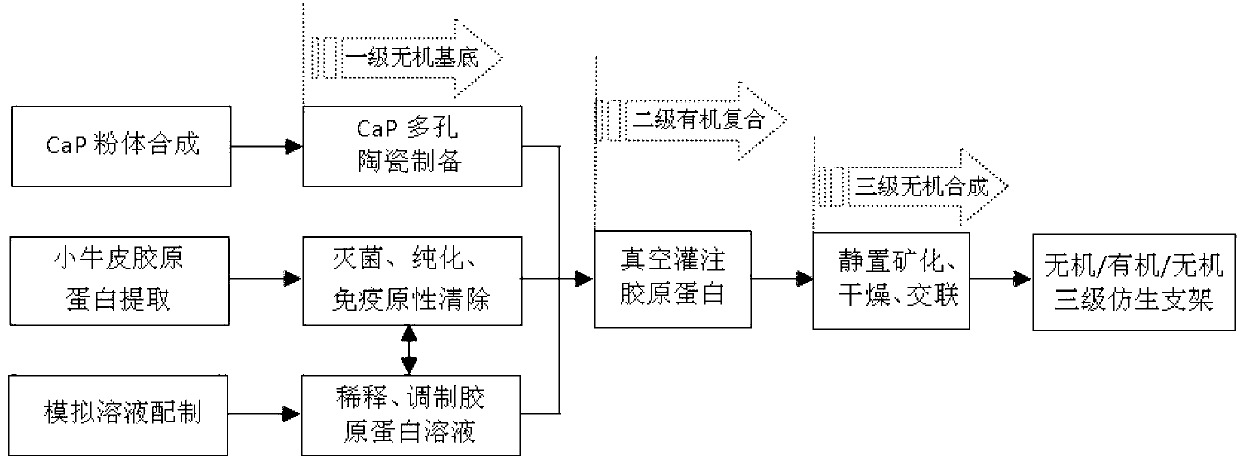Calcium phosphate/collagen/bone-like apatite three-level bionic bone tissue engineering scaffold and preparation method thereof
A technology of tissue engineering scaffold and bone-like apatite, which is applied in the field of biomedical materials, can solve the problems of comprehensive performance and bionic level gap, and achieve good bone formation ability, good mechanical properties, and the effect of promoting bone tissue repair and regeneration
- Summary
- Abstract
- Description
- Claims
- Application Information
AI Technical Summary
Problems solved by technology
Method used
Image
Examples
Embodiment 1
[0049] A tertiary biomimetic scaffold for bone tissue engineering synthesized on the basis of porous hydroxyapatite ceramics. Its production specific steps are as follows:
[0050] 1) Customized porous calcium phosphate ceramic products. Product pore requirements: overall porosity 85%±5%, macropore diameter 400±50μm, interpenetrating micropore diameter 80±20μm, cut into thin discs of Φ15×2 mm;
[0051] a) The hydroxyapatite powder prepared by the wet reaction is screened with a standard type sieve to screen out the dry hydroxyapatite powder with a diameter of 80-160 μm, and then the porous ceramics of 20×20×50 mm are prepared by hydrogen peroxide foaming method Embryo body, low temperature <100 ℃ drying;
[0052] b) Put the ceramic green body into a muffle furnace for sintering, raise the temperature from room temperature to 1100 °C at a rate of 5 °C / min for 2 hours for sintering, and then cool with the furnace. Then cut into thin round test pieces of Φ15×2 mm;
[0053] 2)...
Embodiment 2
[0058] Synthesis of tertiary biomimetic bone tissue engineering scaffolds based on porous β-tricalcium phosphate (β-TCP) ceramics. The porosity of the porous ceramic matrix is 85%±5%, the diameter of the macropores is 400±50 μm, and the diameter of the interpenetrating micropores is 80±20 μm. The rest of the product preparation process and steps are the same as in Example 1. The scanning electron microscope picture of the porous β-tricalcium phosphate ceramics obtained is as follows figure 2 As shown in (a), figure 2 Middle (b) is the SEM image of collagen fibers composited in the internal pores of the porous calcium phosphate ceramic material, figure 2 Middle (c) is the SEM image of the sheet-like bone-like apatite generated on the collagen fiber template in the internal pores of the porous calcium phosphate ceramic material. The mass percentages (wt%) of calcium phosphate / collagen / bone-like apatite are: calcium phosphate ceramics-85%, collagen-14.5%, and bone-like apa...
Embodiment 3
[0060] Other conditions and processes are the same as those in Example 2, except that porous β-tricalcium phosphate ceramics with high porosity are used as the matrix to synthesize a three-level biomimetic bone tissue engineering scaffold. The ceramic porosity is 95%±5%, the macropore diameter is 500±100μm, and the interpenetrating micropore diameter is 100±20μm. The mass percentages (wt%) of the obtained calcium phosphate / collagen / bone-like apatite are: calcium phosphate ceramics-80%, collagen-19% and bone-like apatite-1%. The increase in the porosity of ceramics is conducive to the perfusion and compounding of more collagen, and is also conducive to the formation of bone-like apatite layers.
PUM
| Property | Measurement | Unit |
|---|---|---|
| pore size | aaaaa | aaaaa |
| length | aaaaa | aaaaa |
| width | aaaaa | aaaaa |
Abstract
Description
Claims
Application Information
 Login to View More
Login to View More - Generate Ideas
- Intellectual Property
- Life Sciences
- Materials
- Tech Scout
- Unparalleled Data Quality
- Higher Quality Content
- 60% Fewer Hallucinations
Browse by: Latest US Patents, China's latest patents, Technical Efficacy Thesaurus, Application Domain, Technology Topic, Popular Technical Reports.
© 2025 PatSnap. All rights reserved.Legal|Privacy policy|Modern Slavery Act Transparency Statement|Sitemap|About US| Contact US: help@patsnap.com



